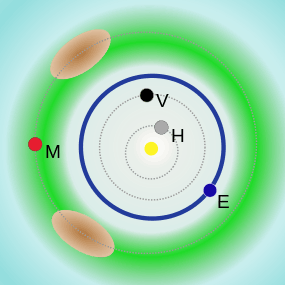719 Albert
| Discovery [1][2] | |
|---|---|
| Discovered by | Johann Palisa |
| Discovery site | Vienna Obs. |
| Discovery date | 3 October 1911 |
| Designations | |
| MPC designation | 719 |
Named after | Albert Salomon von Rothschild |
| 1911 MT; 2000 JW8 | |
|
Mars-crosser Amor  | |
| Orbital characteristics [2][3] | |
| Epoch 31 July 2016 (JD 2457600.5) | |
| Uncertainty parameter 0 | |
| Observation arc | 104.34 yr (38111 d) |
| Aphelion | 4.0844 AU (611.02 Gm) |
| Perihelion | 1.1875 AU (177.65 Gm) |
| 2.6359 AU (394.33 Gm) | |
| Eccentricity | 0.54951 |
| 4.28 yr (1563.1 d) | |
Average orbital speed | 16.87 km/s |
| 178.61° | |
| 0° 13m 49.08s / day | |
| Inclination | 11.579° |
| 183.93° | |
| 2456825 JED | |
| 156.13° | |
| Earth MOID | 0.194045 AU (29.0287 Gm) |
| Jupiter MOID | 1.40528 AU (210.227 Gm) |
| Jupiter Tisserand parameter | 3.139 |
| Physical characteristics | |
| Dimensions | 2.4 km[4] |
| Mass | 1.4×1013 kg |
Mean density | 2.0? g/cm³ |
Equatorial surface gravity | ~ 0.0007 m/s² |
Equatorial escape velocity | ~ 0.0013 km/s |
|
5.802 h[5] 5.801 h (0.2417 d)[2] | |
| assumed 0.15[4] or 0.12[5] | |
| Temperature | ~ 171 K |
| S[6] | |
| 15.5 | |
|
| |
719 Albert is a Mars-crossing, Amor asteroid; it was the second one discovered after 433 Eros.
Discovery
Discovered in 1911 by Johann Palisa, the asteroid was named after one of the Imperial Observatory in Vienna's major benefactors, Albert Salomon von Rothschild, who had died some months before.[1] Due to inaccuracies in the asteroid's computed orbit it was subsequently lost and not recovered until 2000 by Jeffrey Larsen using data from the Spacewatch asteroid survey project.[1] When it was recovered in 2000, Albert was the last "lost asteroid" among those assigned numbers (69230 Hermes was not numbered until 2003). The second-to-last "lost" numbered asteroid, 878 Mildred, had been recovered in 1991.[1]
When it was rediscovered, 719 Albert was mistakenly thought to be a new asteroid and was designated 2000 JW8.[7] Upon further investigation, however, it was noticed that its orbital plane matched up nicely with the last remaining "lost" asteroid and it was properly identified. Using the new observational data the period was determined to be about 4.28 years instead of the 4.1 years calculated in 1911; this was the primary reason the asteroid was lost.[1]
...asteroids were sometimes assigned numbers before accurate orbital elements had been determined, and so some numbered asteroids could not later be located. These objects were referred to as “lost” asteroids. The final lost numbered asteroid, (719) Albert, was recovered in 2000 after a lapse of 89 years. Many newly discovered asteroids still become “lost” ...— Encyclopædia Britannica [8]
Physical properties
Most of what is known about 719 Albert comes from observations taken after its rediscovery. In 2001 it passed near the Earth, allowing for a series of observations at differing phase angles. During this pass its rotational period was calculated at 5.802 hours and a measured absolute magnitude of 15.43 together with an assumed albedo of 0.12 gave a diameter of 2.8 km.[5] Another group led by R. P. Binzel measured an absolute magnitude of 15.8; they however used an assumed albedo of 0.15 leading to a calculated diameter of 2.4 km.[4] Other observations carried out in October 2001 at the 5 meter Hale Telescope by Binzel et al. classified it as an S-type asteroid.[6]
References
- 1 2 3 4 5 Cowen, Ron (2000-05-20). "Astronomers Rediscover Long-Lost Asteroid". 157 (21). Science News.
- 1 2 3 "JPL Small-Body Database Browser: 719 Albert (1911 MT)" (12 February 2015 last obs). Retrieved 6 May 2016.
- ↑ "MPEC 2000-J37 : (719) Albert = 2000 JW8". 9 May 2000. Retrieved 24 September 2015.
- 1 2 3 Binzel, R. P.; et al. (2002). "Physical Properties of Near-Earth Objects" (PDF). Asteroids III. University of Arizona Press: 255–271. ISBN 0-8165-2281-2.
- 1 2 3 Krugly, Yu. N.; Belskaya, I. N.; Chiorny, V. G.; Shevchenko, V. G.; Gaftonyuk, N. M. (November 2002). "CCD Photometry of Near-Earth Asteroids in 2001". Proceedings of Asteroids, Comets, Meteors. 500: 903–906. Bibcode:2002ESASP.500..903K. ISBN 92-9092-810-7.
- 1 2 Binzel, R. P.; et al. (August 2004). "Observed spectral properties of near-Earth objects: results for population distribution, source regions, and space weathering processes" (PDF). Icarus. 170 (2): 259–294. Bibcode:2004Icar..170..259B. doi:10.1016/j.icarus.2004.04.004.
- ↑ "IAU Circular: IAUC 7420". 9 May 2000.
- ↑ "Lost Asteroid". Encyclopædia Britannica Online. 2009. Retrieved 27 February 2009.
External links
- Minor Planet Center Database entry on (719) Albert
- 719 Albert at the JPL Small-Body Database

- EARN Database: 719 Albert